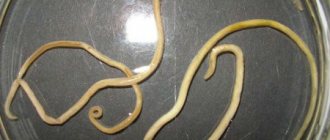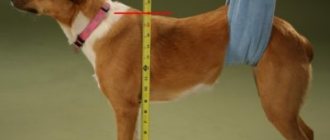Worms are parasitic worms that live, feed and reproduce in the donor's body. They enter the digestive tract, spread throughout the organs and do not manifest themselves for years. But all this time, great harm is done to the dog’s health. And communication with a pet can cause infection to humans and other pets.
Ways of infection with worms
In the vast majority of cases, a dog becomes infected with worms by ingesting their eggs.
But there is another way of infection - transmissible, through the bites of blood-sucking insects. In addition, the parasite can enter through lesions on the animal's skin. Newborn puppies easily become infected from their mother, who is a carrier of helminthic infestation. Helminth eggs can enter the pet’s body if:
- the owner does not pay enough attention to the sanitary and hygienic side of the life of his four-legged friend;
- the dog is not given preventive deworming;
- the pet eats raw meat and fish;
- the dog often walks unaccompanied (dubious “acquaintances” are possible, drinking from puddles, eating various leftovers, and so on);
- There are other animals living in the apartment that have worms.
Under other favorable conditions, a pet can become infected even at home by sniffing the shoes of an owner who comes in from the street.
Note: no dog is immune from worms, but the risk group includes animals with weakened immune systems, puppies, hunting and yard dogs.
What drugs to choose for deworming?
Of course, any symptoms of helminthic infestation are a reason to seek medical help. But self-treatment is not recommended, as you may not only fail to achieve positive results, but also worsen your pet’s condition.
To determine the type of parasite, it is necessary to submit a stool sample for laboratory testing. Only after the results obtained will the doctor be able to prescribe effective therapy using anthelmintics.
For puppies, such drugs are prescribed only taking into account their age, the most common of them are:
- Drontal Junior is an effective remedy against nematodes and can be given to puppies from two weeks of age. You can also watch Drontal Plus.
- Prazitel is a universal remedy that affects almost all types of parasitic worms (round, tape, flat), often prescribed for mixed types of infection; it is also possible to treat puppies from two weeks old.
- Prazicide in the form of a suspension is an antiparasitic drug that has a wide range of effects against nematodes and cestodes. Allowed for use only from three weeks.
Effective anthelmintics suitable for adult dogs include the following:
- Helminthal is a suspension that rids the animal’s body of tapeworms and nematodes.
- Drontsit is available in two forms - liquid (in the form of a solution) and tablets. Has a powerful effect against intestinal worms.
- Milbemax is a product intended for small breeds, with its help you can rid your pet of round and tape parasites.
Before giving the drug to an animal, you need to carefully read the information provided in the instructions and follow the recommendations specified therein. It is imperative to observe the dosage of the product, otherwise the active components of the drug can harm the pet’s body weakened by worms. If you reduce the dosage, it will not be possible to remove the parasites, but a larger dose will cause intoxication.
Why are helminths dangerous for dogs?
If left untreated, worms in dogs can lead to serious consequences over time, including:
- weakened immunity and retarded growth and development due to insufficient supply of nutrients to the animal’s body;
- mental exhaustion of the dog due to constant itching, pain, discomfort;
- the addition of infection against the background of a decrease in protective forces, the development of numerous diseases;
- serious intoxication of the pet’s body with toxic metabolic products of parasites, the development of allergic reactions.
Helminths lead to diseases of the liver, brain, heart, lungs and other organs. Ignoring the symptoms of worms in a dog is fraught with the development of jaundice, heart attack, epilepsy, intestinal obstruction, cerebral hemorrhage, loss of vision and other consequences, including death.
Important: according to statistics, more than 60% of domestic dogs are infested with helminths. At the same time, infected pets look clinically healthy, so owners do not always suspect that their beloved animal is sick.
Intestinal parasites in dogs
Types of helminths
There are a huge number of varieties of worms. Of course, each type results in different symptoms. However, all of them can be divided into three large groups - flatworms (cestodes), roundworms (nematodes) and flukes (trematodes). Veterinarians can accurately determine which remedy is suitable for your dog after diagnosing the type of worms.
Each type can cause serious diseases, which without proper care can worsen or even become chronic. In addition, worms in dogs can cause infection of other pets and people in the family.
Not all worms live in the intestines. Some of them choose the lungs, liver or pancreas as their home. Having settled in the organs, they begin to destroy them. That is why the disease cannot be left unattended. In rare cases, an animal may die from severe helminthiasis.
Intestinal parasites
This is the most common type of worm. The eggs enter the body through food or liquid and immediately begin to develop. Intestinal parasites mainly include tapeworms or roundworms. They can cause serious diseases such as echinococcosis, toxocariasis or hookworm.
Of course, each type of worm in dogs has specific symptoms, but there are several general signs that can be used to determine the presence of worms in the body. These include diarrhea or constipation, rapid weight loss, vomiting, lethargy, fatigue and exhaustion. Intestinal worms in dogs can clump together inside the small intestine, blocking it. If you don't provide emergency assistance to your dog, it could lead to death.
Lungworms
Often there are helminths that can spread throughout the host’s body. They move from organ to organ through soft tissues, destroying them. Having found the most favorable place for living, they settle there and begin to reproduce. One of the representatives of such parasites are roundworms. They are most often found in the lungs or stomach of animals.
If your dog experiences symptoms such as coughing, difficulty, noisy or intermittent breathing, sputum, weight loss, it is likely that he has just such “residents”. Their vital activity in the body rarely goes unnoticed. Moving inside the pet's body, they deform tissues, which often leads to internal bleeding.
The owner cannot be completely sure that a pet has lungworms. Only laboratory analysis will show an accurate result.
Heart parasites
Perhaps the most dangerous helminths are considered to be cardionematodes. Worms live mainly inside arteries, veins, in the atria of an animal, or even in the heart itself. They can enter the body through the bite of a mosquito, flea or any other blood-sucking insect. A pet may not show signs of infection for up to 6-8 months.
As soon as the incubation period ends and the parasites begin to act, the dog will experience shortness of breath, wheezing or noisy breathing, fatigue and nervousness. The animal may almost completely refuse to eat, behave lethargically, not take part in games and not even go for walks.
Under no circumstances should you delay removing worms from dogs. The doctor must prescribe a specialized medicine, which will be based on the general condition of the body. Otherwise, sudden death due to cardiac arrest or rupture is possible. Small breed dogs are at risk.
Liver parasites
As soon as the worms settle in the animal’s liver, its health and appearance deteriorate. First of all, the pet’s fur becomes dull, lethargy and an unpleasant odor from the mouth appear. The dog may not lose its appetite, but its weight is rapidly decreasing.
The abdominal area on the right increases, and ascites is often observed - accumulation of fluid in the abdominal cavity. When palpating the liver, its heterogeneity is felt, and the dog becomes restless and may even whine in pain.
Subcutaneous worms
This is a fairly rare occurrence, but it can still occur in any dog. The insidiousness of infection with subcutaneous worms in dogs is asymptomatic, which can last several months. As soon as the disease shows itself, the dog develops:
- swelling of the muzzle;
- scratching that occurs due to knotty blisters on the skin;
- strong thirst;
- lethargy, drowsiness;
- darkening of urine.
For all of the listed symptoms of subcutaneous worms in dogs, you must contact a veterinary clinic, since independent treatment in this case is impossible.
Symptoms of worms in dogs
At the beginning of the disease, it is quite difficult to determine the presence of worms in a dog. Signs of helminthiasis begin to appear when the parasites have multiplied and caused significant harm to the body. In this case, the owner can find in the dog’s feces both the worms themselves, which have come out of the intestines, and their eggs in the form of tiny grains.
However, it is not always possible to see worms or their eggs with the naked eye. It is possible to suspect helminthiasis in a pet based on the following symptoms:
- the dog loses weight with an excellent appetite;
- the fur has become dull;
- the animal licks the anus and/or rubs its anus on the floor;
- the pet is breathing heavily and has a cough;
- bloated belly (especially in puppyhood);
- difficult bowel movements alternating with diarrhea;
- lack of appetite;
- vomit;
- skin rashes.
Important: if you notice such symptoms, you should first consult a veterinarian. The same signs may indicate the development of other disorders, so you cannot independently administer medications for parasites based only on the listed manifestations.
How to remove worms at home
Signs of helminths in dogs may coincide with symptoms of other diseases, so consultation with a veterinarian is always necessary to establish an accurate diagnosis. In rare cases, surgery or treatment under the supervision of a gastroenterologist may be required, but most often the problem can be solved by taking medications at home.
When treating, it is important to also treat the dog’s sleeping area and other places and rooms where there may be parasite eggs. If there are several pets living in your home, all should be treated at the same time, even if signs are found in only one.
Diagnosis of helminthiases
If you suspect helminthiasis, you should contact a veterinary clinic for diagnostic measures. Diagnosis of worms in dogs consists of laboratory testing of blood and feces. Analyzes make it possible not only to identify the presence of parasites, but also to determine their species.
Many owners believe that to diagnose helminthiasis it is enough to test their pet’s feces. However, some worms that live in the heart or lungs can only be detected by testing the animal's blood. Preference is given to enzyme-linked immunosorbent assay (ELISA) or polymerase chain reaction (PCR). These methods are considered the most informative.
If a pulmonary or cardiac form of helminthiasis is suspected, the doctor may prescribe an X-ray examination and/or ultrasound of the heart.
Attention: even if the owner knows what a particular parasite looks like, if you find worms in the dog’s feces, you should definitely submit stool for diagnosis. It is quite possible that other helminths will be present in the animal’s body.
Heartworms
One of the most unpleasant and dangerous types of nematodes in dogs.
These are long (up to 40 cm) filamentous worms that live in the pulmonary artery and heart, and with a high degree of invasion they are found in the vena cava. The intermediate hosts (who carry the larvae) are mosquitoes, the final hosts are canines, because Only in their body can the parasite complete the full development cycle. The larvae grow and develop in the dog’s body for up to 250 days. Microfilariae (larvae) are carried by the bloodstream to all organs and tissues; they can live under the skin and in organs, provoking inflammation in these places. One of the first signs of worms (heartworms) in a dog is general malaise, as well as hemoptysis, shortness of breath, and exhaustion.
Heartworms can also settle in the human body, getting under the skin or in the eye; the larvae develop within 4-5 months. The full development cycle is not achieved, but its presence itself causes long-term dermatitis that is difficult to treat.
How to properly deworm dogs
In order to completely and without complications expel worms from a domestic dog, you need to follow certain rules.
- Get tested first at a veterinary clinic.
- Carefully read the instructions for the deworming medication.
- As a rule, the medicine is given in the morning and on an empty stomach to avoid vomiting (unless otherwise recommended).
- Before taking the product, your pet must be treated against insects (several days before).
- In the process of destroying parasites, the dog must drink a lot - make sure there is clean water in the bowl.
- During treatment, it is advisable to protect the liver from toxins released by dying worms. You need to ask your veterinarian in advance what medications can be used.
- Be sure to make sure that the animal has a bowel movement in the next few hours. Otherwise, you need to give your pet a laxative.
- Be sure to re-treat after 10-14 days.
During deworming, you need to carefully monitor the dog's condition. If there is a significant accumulation of parasites during their mass death, the animal may experience severe intoxication: vomiting, clouding of consciousness, convulsions. This condition requires treatment in a clinic (intravenous administration of drugs) under the supervision of a specialist.
Treatment
The first treatment of puppies for any type of worms should be carried out at the age of three weeks. Babies, pregnant and lactating bitches, and elderly pets are extremely sensitive to toxins that are released after the parasites die. Therefore, to treat them, it is necessary to use special anti-worm medications for dogs. In addition, veterinarians recommend giving them a spoonful of Vaseline oil to quickly remove decay products.
Pills
The anthelmintic in tablet form is crushed and added to the pet’s food. After two weeks, the treatment is repeated. In this way, larvae and young worms are destroyed, which were protected by the egg shell at the time of the first administration of the medicine. Quality drugs include Milbemax, Drontsit, Alben, Bicheldon, Brovanol.
Suspensions
The advantage of this form of anthelmintic drug is the ease of measuring the dosage. In addition, suspensions often have a pleasant smell and taste for the pet. To treat worms, you need to take the suspension into a syringe, remove the needle and squeeze the medicine into the animal’s mouth. Veterinarians recommend the drugs Helmintal, Dironet, Dironet Junior, Dirofen, Prazitel.
Drops on the withers
Liquid deworming medications for dogs perform several functions. They destroy helminths in the animal’s body and ectoparasites on its fur. Drops are applied to the area between the shoulder blades so that the dog cannot lick off the medicine. The liquid is quickly absorbed through the pores of the skin into the bloodstream and destroys parasites. Quality products – Prazicide Complex, Inspector, Lawyer, Stronghold, Helmintal.
Traditional medicine
Folk remedies for worms for dogs only help get rid of intestinal parasites. Additionally, it is very difficult to calculate the dosage of a home remedy. A low concentration of the main substance will not be able to destroy helminths, but too high will harm the health of the pet. Medicinal plants with similar effects include tansy, celandine, wormwood, garlic, and pumpkin seeds.
Preventive actions
Unfortunately, it is not possible to completely prevent a dog from becoming infected with worms. However, the risk of helminthiasis can be significantly reduced with the help of basic preventive measures.
- Deworm your pet in a timely manner, observing the timing and dosage.
- Periodically test feces for helminthiasis, even in the absence of corresponding symptoms.
- Eliminate raw fish and tripe from your diet. Process raw meat with boiling water.
- Do not allow your dog to drink from puddles or open water or pick up pieces of food on the street.
- Promptly identify and destroy blood-sucking insects. Treat the animal with products for external use.
- Avoid unnecessary “acquaintances” with your pet.
- Regularly wash your dog's bedding and water and food bowls.
Prevention measures
Among such measures are:
- Carrying out deworming of the female dog before mating to prevent infection with helminths from the partner.
- Two weeks after the birth of puppies, preventive treatment is carried out.
- Walk dogs only in designated areas.
- You should not allow your dog to eat food picked up on the street.
- Drinking water must be clean.
- Regularly exterminate fleas.
- It is not recommended to feed animals raw food, meat, fish.
If you follow simple precautions, your pet will be healthy and playful, and you will not have to worry about your future canine offspring. You will protect yourself from the possibility of becoming infected with worms from your dog.
Is it possible to get worms from a dog?
Humans and other pets can easily become infected with certain types of worms, such as echinococcosis, from dogs. Helminth eggs enter the body after communicating with the dog from unwashed hands, from under the nails. They can enter through the mucous membranes, for example, if a person rubs their nose or sneezes.
To avoid infection, you need to avoid kissing your pet, wash your hands with soap every time after communication, and limit its location in the apartment, not allowing it on your bed or at the table. In addition, frequent wet cleaning using disinfectants will help reduce the likelihood of infection.
Common medications for treating white worms
The most commonly used drugs are:
- Pyrantel and all its derivatives are very effective against almost all types of parasitic roundworms.
- With cestodes, everything is somewhat more complicated, since these parasites are more difficult to completely destroy. To treat animals with cestodias in veterinary medicine, the aid compounds praziquantel, epsiprantel, and fenbendazole are actively used. The most common drugs are based on praziquantel and fenbendazole, but practicing veterinarians advise the use of epsiprantel derivatives. The fact is that they are not only highly effective, but also practically safe for the animals themselves, even with a fairly strong overdose.
However, in many cases there is no need to take a special look at the composition of medicines: most of the products produced by the modern pharmaceutical industry are equally effective against both round and flatworms.
As for trematodes, the same derivatives of praziquantel, epsiprantel and fenbendazole are used to treat the diseases they cause.
When to give deworming medicine to your dog
Dogs are first dewormed at about 3 weeks of age as a puppy. Next, medicine for worms is given depending on vaccination - 2-3 weeks before vaccination, and then every six months. As they grow older, it is recommended to worm dogs once every 3-6 months, and also 2-3 weeks before vaccination. Female dogs need to be dewormed before a planned mating, as well as after estrus. Pregnant animals are not given anthelmintic drugs.
It should be taken into account that in order to completely destroy worms in dogs, the medicine should be given twice, with a break of 10-14 days. This will allow you to destroy adult parasites and those that emerge from the larvae during this time.
Danger to humans
A dog or puppy with worms, when interacting with a person, can infect him with helminthiasis. The larvae and eggs of parasites leave the animal's body in the feces. They can attach to the pet's fur, bedding or toys, and then end up in the owner's hands.
Due to the difference in body temperature, not all dog worms can live in the human body. But some of them can cause dangerous diseases.
- Toxocara canis. The larvae migrate through the human circulatory system, settling in various organs. As a result, ocular or visceral toxocariasis develops. It affects the lungs, liver, eyes, and central nervous system.
- Echinococcus granulosus. The larvae of this helminth are extremely dangerous for the human body, although they cannot develop in it. They migrate throughout the body and settle in the lungs, forming a cyst. The neoplasm causes coughing and chest pain.
- Echinococcus multilocularis. The larvae of this tapeworm settle in the human liver and also form a cyst. When a secondary infection occurs, jaundice, abscess, and cirrhosis of the liver develop.
- Coenurus cerebralis. The larvae of such worms look like a water bubble. They settle in the area of the spinal cord or brain. Depending on the location of the lesion, a person suffers from migraines, seizures, and decreased vision.
- Dipylidium caninum. The tapeworm takes root in the human intestine, develops, grows, and reproduces. As a result, the patient suffers from diarrhea, skin rash, and abdominal pain.
Timely deworming and proper personal hygiene will help avoid the development of these diseases.
How to collect dog stool for analysis
To do a stool test for the presence of worms, simply take a small amount of dog feces and take it to the laboratory. Feces can be placed in a container (special containers are sold in regular pharmacies) or, as a last resort, in a plastic bag. If it is not possible to transport it immediately, it is allowed to store the material for 1-2 days at a temperature not exceeding 30 °C (best - 3-10 °C). To detect worm larvae, it is not necessary that the feces be fresh.
Sometimes it is necessary to do a series of sequential stool tests for worms. In this case, feces should be collected after each bowel movement of the dog. Serial diagnostics increases the reliability of the results obtained.











